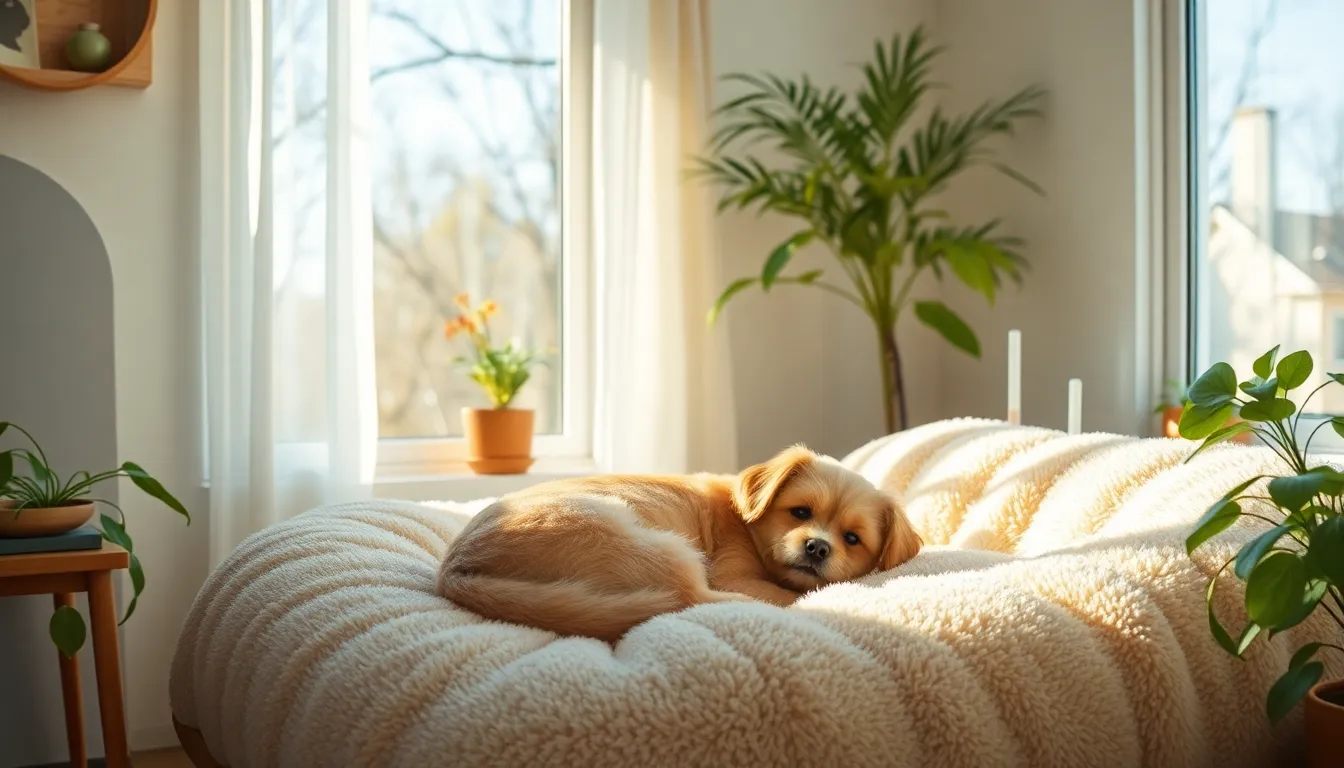Every pet has that magical spot where they feel like royalty—be it a sunlit patch on the floor or a cozy corner of the couch. These comfort zones aren’t just places; they’re sanctuaries where pets can recharge and let their quirky personalities shine. Understanding these unique hideaways not only deepens the bond between humans and their furry friends but also ensures a happier, healthier life for them.
Table of Contents
ToggleUnderstanding Pet Comfort Zones
Pets often establish comfort zones that cater to their unique needs. These spaces allow them to feel secure and content.
Definition of Comfort Zones
Comfort zones refer to specific areas where pets feel relaxed and safe. Examples include sunny spots or quiet corners in the home. Each pet may choose different locations based on their personality and preferences. For instance, a cat might prefer a hidden nook while a dog enjoys an open sunny area. Understanding these preferences helps owners provide environments that cater to their pets’ needs.
Importance for Pet Well-being
Recognizing comfort zones significantly impacts pet well-being. A safe space allows pets to de-stress and recharge. Pets that frequently access their comfort zones tend to exhibit positive behaviors, such as reduced anxiety and increased playfulness. Additionally, these areas foster independence, enabling pets to retreat when feeling overwhelmed. Prioritizing comfort zones ultimately enhances the overall happiness and health of pets, strengthening the bond between them and their owners.
Identifying Your Pet’s Comfort Zone

Recognizing a pet’s comfort zone involves careful observation and understanding of their behavior. Each pet exhibits unique preferences that indicate their preferred safe spaces.
Observational Signs
Pets display various signs that point to their comfort zones. They may seek out specific locations within the home that offer warmth or seclusion. Signs of relaxation, such as deep breathing or an open body posture, signal contentment. Additionally, a pet might nestle into blankets or curl up in a favored spot when feeling secure. Reacting positively to gentle interactions like petting often indicates they enjoy their surroundings. Monitoring these behaviors helps identify ideal areas for them to retreat.
Common Habitats
Common habitats for pets often include cozy corners, sunny windowsills, or quiet rooms. Cats might favor hidden recesses where they can observe without being seen. Dogs may prefer open spaces that allow for visibility and sunlight. Each pet’s characteristics determine their choice of comfort zone. For instance, a shy cat might opt for an enclosed bed while an outgoing dog might lounge in an accessible area near family activities. Understanding these common habitats enriches pet care and enhances overall well-being.
Creating a Safe Comfort Zone
Creating a safe comfort zone for pets involves environmental adjustments and emotional support strategies. Both aspects contribute significantly to their overall happiness and well-being.
Physical Environment Adjustments
Adjusting the physical environment enhances a pet’s comfort. Provide cozy bedding in quiet corners for pets to retreat. Configure furniture to create pathways, allowing exploration without obstacles. Designate areas where sunlight streams in, offering warmth and relaxation. Maintain a clean space to prevent stressors like dust and allergens. Incorporate toys and familiar scents, helping pets feel at home. Enclose cozy blankets or cushions, fostering a sense of security. Each adjustment plays a critical role in creating a haven tailored to specific needs.
Emotional Support Techniques
Emotional support proves vital in establishing a safe comfort zone. Incorporate routines to provide predictability, as it helps alleviate anxiety. Encourage positive interactions through gentle petting or calm voices, reinforcing bonds. Offer treats during quiet moments to promote relaxed behavior. Recognize stress signs and intervene promptly with soothing words or actions. Engage in playtime to strengthen connections and stimulate a pet’s playful side. Each emotional technique nurtures trust, fostering a sense of safety that pets deeply appreciate.
Common Myths About Pet Comfort Zones
Many people believe pets only need comfort zones during stressful situations. This assumption overlooks the everyday need for a safe space where pets can retreat, recharge, and relax. Pets prefer their comfort zones for various reasons, not solely to escape from stressors.
Another common myth suggests all pets share the same comfort zone preferences. Individual personality traits heavily influence a pet’s choices, with some favoring hidden nooks while others enjoy open spaces. Recognizing these differences helps owners create more personalized environments.
Some think that once a pet finds their comfort zone, it remains unchanged. In reality, pets can shift their preferences over time based on their experiences, age, and mood. Observing these changes ensures owners adapt their surroundings accordingly.
Many assume comfort zones are only needed for specific pets, like anxious or shy animals. Regardless of personality, all pets benefit from having dedicated safe spaces, contributing to their overall well-being and happiness. Each pet’s comfort zone plays a crucial role in their emotional health.
Another myth posits that comfort zones lack any significance in a pet’s life. In truth, these areas contribute immensely to a pet’s mental health and sense of security. Well-defined comfort zones can reduce anxiety and encourage positive behaviors.
Some individuals believe that providing a comfort zone should only involve physical aspects, ignoring the importance of emotional support. Both physical adjustments, like cozy bedding, and emotional elements, like consistent routines, play essential roles in fostering a nurturing environment.
Recognizing and respecting a pet’s comfort zone is essential for their overall happiness and well-being. These safe spaces not only allow pets to recharge but also enhance the bond between them and their owners. By observing their behaviors and preferences, pet owners can create environments tailored to their furry companions’ needs.
Implementing strategies for both physical comfort and emotional support fosters a nurturing atmosphere that promotes security and reduces stress. Understanding the unique preferences of each pet ensures they thrive in their surroundings, ultimately leading to a more fulfilling life for both pets and their humans. Prioritizing these comfort zones is a simple yet impactful way to enhance a pet’s quality of life.








